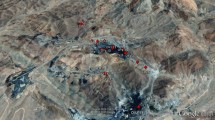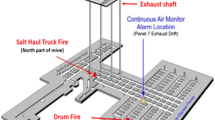Abstract
Radioactive lightning rods were manufactured in Brazil until 1989, when the licenses for using radioactive sources in these products were lifted by the national nuclear authority. Since then, these rods have been replaced by the Franklin type and collected as radioactive waste. However, only 20% of the estimated total number of installed rods has been delivered to the Brazilian Nuclear Commission. This situation causes concern, since there is the possibility of the rods to be disposed as domestic waste. In Brazil, 64% of the municipal solid waste is disposed at garbage dumps without sufficient control. In addition, 241Am, the radionuclide most commonly employed, is classified as a high-toxicity element, when incorporated. In the present study, 241Am migration experiments were performed by means of a lysimeter system, in order to evaluate the risk of contamination caused by radioactive lightning rods disposed as common solid waste. 241Am sources removed from lightning rods were placed inside lysimeters filled with organic waste that was collected at the restaurant of the Instituto de Pesquisas Energéticas e Nucleares. The generated leachate was periodically analyzed, and characteristics such as pH, redox potential, solid content and the concentration of the radioactive material were determined. The equivalent dose for members of the public was calculated considering ingestion of contaminated drinking water as the major path of exposure. Estimated doses were about 20-times below the effective dose limit of 1 mSv year−1 for members of the public as recommended by the International Commission on Radiological Protection. This suggests the radiation risk caused by lightning rods disposed at uncontrolled garbage dumps to be low. It should be noted, however, that the number of investigated lightning rods was quite small. The results of this study might therefore not be entirely representative and should be interpreted with care. They provide, however, a very first basis for characterizing the transfer of 241Am from lightning rods to the human food chain.







Similar content being viewed by others
References
Heilbron Filho PFL, Xavier AM (1992) Radioactive lightning rods: protection or danger? In: IV Congresso Geral de Energia Nuclear, 5–9 de julho, 1992, Rio de Janeiro, pp. 493–498. (in Portuguese)
US Environmental Protection Agency. Toxicity characteristic leaching procedure (Method 1311). July/1992. Available at: http://www.epa.gov/epaoswer/hazwaste/test/main.htm. Cited 30 May 2007
Fornaro A, Gutz IGR (2006) Wet deposition and related atmospheric chemistry in the São Paulo metropolis, Brazil. Part 3: trends in precipitation chemistry during 1983–2003. Atmos Environ 40:5893–5901
Instituto de Pesquisas Espaciais (2006) Clima. http://www.cptec.inpe.br/clima/monit/monitor_brasil.shtml. Cited 15 Feb 2006
Miranda LET, Vicente R (1999) A process for managing radioactive lightning rods in Brazil. Instituto de Pesquisas Energéticas e Nucleares. Departamento de Rejeitos Radioativos. São Paulo (in Portuguese)
Christensen TH, Kjeldsen P (1989) Basic biochemical process in landfills. In: Christensen TH, Cossu R, Stegmann R (eds). Sanitary landfilling: process, technology and environmental impact. Academic Press, London, pp 29−49
Kelly EJ, Bell DI, Johnstone TL (1998) Lysimeter studies to investigate the leaching of 241Am from low level radioactive waste. J Alloys Compd 271–273, 227–230
Bozkurt S, Moreno L, Neretnieks I (1999) Long-term fate of organics in waste deposits and its effect on metal release. Sci Total Environ 228:135–152
Zhang YJ, Bryan ND, Livens FR, Jones MN (1997) Selectivity in the complexation of actinides by humic substances. Environ Pollut 96(3):361–367
World Health Organization (2004) Guidelines for drinking-water quality. 3rd edn. V.1––Recommendations. Geneva, 2004. Available at http://www.who.int/water_sanitation_health/dwq/gdwq3rev/en/index.html. Cited 16 October 2006
National Health and Medical Research Council (1996) Australian drinking water guidelines. Canberra, 1996. http://www.nhmrc.gov.au/publications/synopses/eh19syn.htm. Cited 15 March 2006
Till JE, Aanenson JW, Killough GG, Meyer KR, Rood AS (1999) Final report. Task 3: inputs and assumptions. Radionuclide soil action level oversight panel. Neese, USA, Risk Assessment Corporation, October 1999 (RAC Report No. 15-RSALOP-RSAL-1999-FINAL). Available at http://www.rfcab.org/RAC-PDF/Task3.pdf. Cited 19 March 2007
International Atomic Energy Agency (1996) International basic safety standards for protection against ionizing radiation and for the safety of radiation sources. Vienna, 1996 (Safety series 115)
Yu C, Loureiro C, Cheng JJ, Jones LG, Wang YY, Chia YP, Faillace E (1993) Data collection handbook to support modeling impacts of radioactive material in soil. Environmental Assessment and Information Sciences Division. Argonne National Laboratory, Argonne, Illinois. Available at http://web.ead.anl.gov/resrad/documents/data_collection.pdf. Cited 22 February 2006
Companhia de Tecnologia de Saneamento Ambiental (2001) Report: establishment of screening levels for soil and groundwater in São Paulo State. São Paulo, Brazil, 2001. Available at http://www.cetesb.sp.gov.br/Solo/solo_geral.asp. Cited 20 May 2006 (in Portuguese)
Urase T, Salequzzaman M, Kobayashi S, Matsuo T, Yamamoto K, Suzuki N (1997) Effect of high concentration of organic and inorganic matters in landfill leachate on the treatment of heavy metals in very low concentration level. Water Sci Technol 36(12):349–356
Kjeldsen P, Barlaz MA, Rooker AP, Baun A, Ledin A, Christensen TH (2002) Present and long-term composition of MSW landfill leachate: a review. Crit Rev Environ Sci Technol 32(4):297–336
Christensen TH, Kjeldsen P, Bjerg PL, Jensen DL, Christensen JB, Baun A, Albrechtsen H-J, Heron G (2001) Biogeochemistry of landfill leachate plumes. Appl Geochem 16:659–718
Author information
Authors and Affiliations
Corresponding author
Rights and permissions
About this article
Cite this article
Marumo, J.T., Isiki, V.L.K., Miyamoto, H. et al. Investigation of the radiation risk due to environmental contamination by 241Am from lightning rods disposed at uncontrolled garbage dumps. Radiat Environ Biophys 47, 131–137 (2008). https://doi.org/10.1007/s00411-007-0130-3
Received:
Accepted:
Published:
Issue Date:
DOI: https://doi.org/10.1007/s00411-007-0130-3




